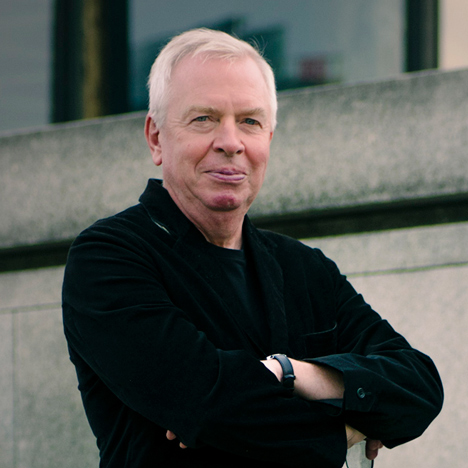
The UK "is not interested in funding" public buildings says David Chipperfield
Interview: the UK is a difficult place to "do architecture" thanks to the dominance of the commercial sector and a lack of government investment says British architect David Chipperfield, whose firm is refurbishing Mies van der Rohe's Neue Nationalgalerie in Berlin.
"The state is not interested in funding" building projects for the public sector in the UK, Chipperfield told Dezeen in an interview this week.
"[The UK is] not an easy place to do architecture," he said. "It's essentially a culture dominated by the commercial sector. And the commercial sector on a larger scale is not very protective about architecture. It needs it and wants it, and wants the bits that it thinks are useful, but the public sector has always been more protective."
Chipperfield has worked extensively across Europe but has only built a handful of structures in the UK.
Recent exceptions have included The Hepworth Wakefield gallery in the north of England and the Turner Contemporary in the seaside town of Margate. But a project to extend the Geffrye Museum is London was lost last year after the scheme became the focus of a preservation campaign.
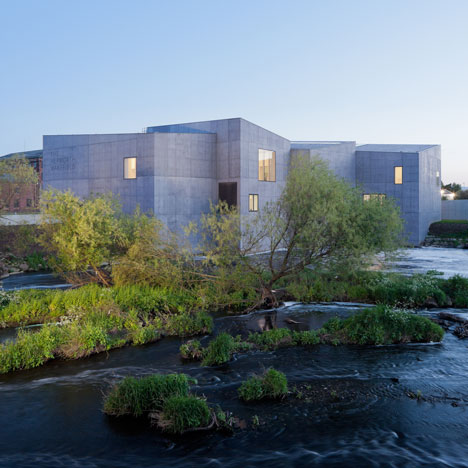
"We've hardly ever worked in the UK. All of our work's been outside. In the past few years we've done a few commercial projects, and we managed to get two museums. But those two museums, they were incredibly difficult," said Chipperfield, who revealed that he had now "downsized" his London office.
Dezeen Book of Interviews: David Chipperfield features in our new book, which is on sale now
His 19-person Berlin office is currently overseeing restoration work on Mies van der Rohe's Neue Nationalgalerie – a museum encased in glass – following on from the success of his renovation of the Neues Museum in Berlin, which won the Mies van der Rohe prize in 2011.
The project involves some reorganisation of the lower floors of the building, as well as creating a new glass facade.
"Mies was slightly optimistic in how he thought the building would perform," said Chipperfield, who explained his task was to make the building look "exactly the same" but newer.
"Essentially it's like taking an old car – taking an old Mercedes – and taking it to bits and getting rid of the rust and putting it back together."
"There's no thermal break in the facade, so there's always condensation on the inside, and then after 50 years that produced a lot of issues," he explained. "There's no expansion, so the glass always cracks, so that's why the glass is always in a bad way. If you look at it from the outside it's not transparent as it should be."
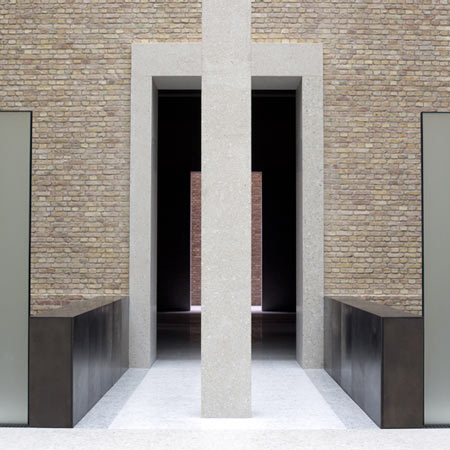
Chipperfield said that his firm had become known as "the most reliable office" for this type of project in Germany: "It's a sign of trust in my office in Berlin that we do these sorts of things."
Meanwhile his Milan office is "developing a certain expertise" for luxury shop design. Chipperfield was talking to Dezeen at the opening of his firm's most recent retail project – a flagship London store for Swiss accessories brand Bally. His flagship New York store for fashion brand Valentino completed last month.
Retail is a difficult because "there's a certain amount of fantasy involved or illusion," said Chipperfield.
"It's a fragile business. If you design a museum of course there are all sorts of other issues but it's not commercial in the same way, and you're playing with quite subtle concerns in shopping. You're trying to seduce people to buy things they probably don't even need."
"It has to work because if it doesn't you don't sell."
Read an edited version of the interview transcript below:
Dan Howarth: What challenges does retail design present?
David Chipperfield: I think it's quite difficult because there's a certain amount of fantasy involved or illusion. If you make architecture and you just make rooms, you could just make good rooms. Whereas with shopping people want a certain atmosphere, or everybody's got a feeling of "oh, it's too cold", or it's 'too this' or 'too that'.
It's a fragile business. If you design a museum of course there are all sorts of other issues but it's not commercial in the same way, and you're playing with quite subtle concerns in shopping. You're trying to seduce people to buy things they probably don't even need.
So you've got to make everything look good, you've got to create a good atmosphere, you've got to deal with all of the practicalities. So it's a meeting of a whole load of concerns and it has to work because if it doesn't you don't sell.
If you do someone's house and they might for the first six months say, 'it's quite modern, I'm not sure, this doesn't work' or 'that doesn't work', but in a way they get used to it. In retail it doesn't work. The sales figures are gone. At that point everyone panics. So it has got to work in another way and there is a lot of detail to sort out.
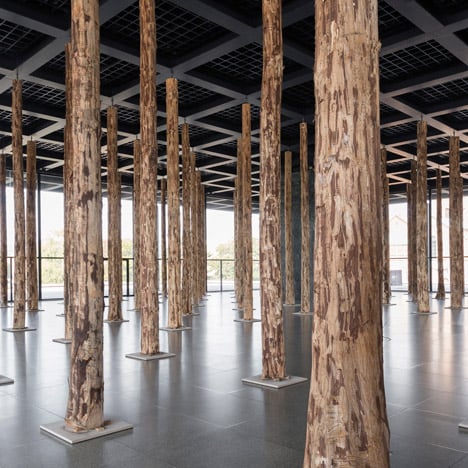
in Mies van der Rohe's Neue Nationalgalerie, which his firm is set to renovate
Dan Howarth: Is there a reason you're doing so much work in retail at the moment?
David Chipperfield: We've always done retail, since the beginning. My very first project was for [Japanese fashion brand] Issey Miyake in 1985. I've always done a small amount of retail. We try not to do too much because you can't come up with too many ideas at the same time in terms of retail. I think Selfridges is a slightly different thing because it's about the store itself, as opposed to working with a brand.
Valentino and Bally are two projects where we're working with a brand, and with Valentino we've been working with them for five or six years, so that's a long development with one brand. And now we're working with Bally. We're doing all of this work from the Milan office. The Milan office has a certain expertise now and I think Valentino has been so successful that we just get a lot of requests.
Dan Howarth: You downsized your London office last year. Has that had an effect on the projects that you take on?
David Chipperfield: We downsized in London a bit, we're still 70 or 80. We were up to a hundred-and-something and that was probably too big. No, it doesn't change the work we take on. It's just a fluctuation of certain projects finishing and certain projects starting. Eighty is still a big office, and there's 18 or 19 in Berlin. There's 14 in Milan. So no, the office capacity overall doesn't affect the work we can do.
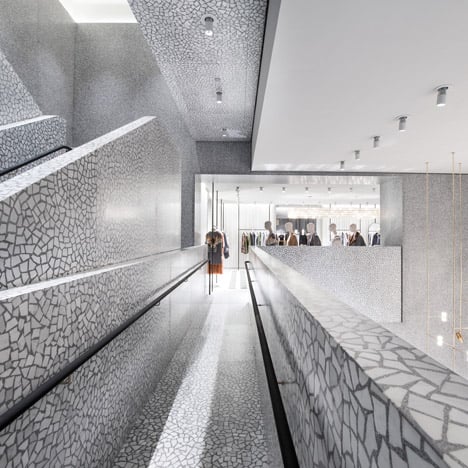
Dan Howarth: What's your reaction to this year's Stirling Prize?
David Chipperfield: I thought it was a good choice. The Stirling Prize is a lottery. Having had our fingers burnt so many times, I'm not the biggest fan of the Stirling Prize. But I think this year was a responsible decision. It's so erratic, I think they've made so many strange choices in the past, so I thought this year was perfectly good. I think it could have gone many ways but I thought at least the selection was good.
I'm much more in favour of the fact that projects should now and in the future be only UK based. I think that's a good decision. It's going to be difficult. The reason why it wasn't in the past is because there was never so much construction of the sorts of projects. But I think there's enough, so I thought it was fine. I thought it was quite a good selection.
Dan Howarth: Is the UK building more of the types of projects that are eligible for awards like the Stirling Prize?
David Chipperfield: [The UK is] not an easy place to do architecture. It's essentially a culture dominated by the commercial sector. And the commercial sector on a larger scale is not very protective about architecture. It needs it and wants it, and wants the bits that it thinks are useful, but the public sector has always been more protective. But having said that I think young architects, like Haworth Tompkins working with theatres, have found a niche within the public sector, which is interesting. When you think of the projects that were shortlisted, if you don't count the Shard, everything else was a public building and we don't do so many public buildings.
Dan Howarth: Why doesn't the UK commission many public buildings?
David Chipperfield: Because the state is not interested in funding them.
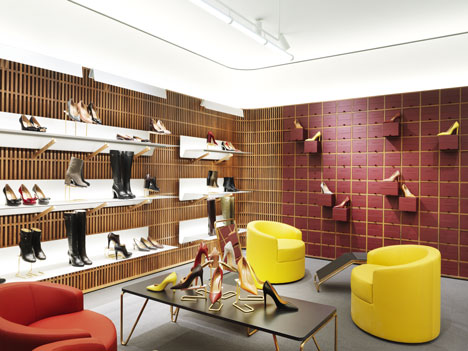
Dan Howarth: After winning the Stirling Prize, Steven Tompkins said he found it difficult to work in the UK for the same reasons you mentioned.
David Chipperfield: We've hardly ever worked in the UK. All of our work's been outside. In the past few years we've done a few commercial projects, and we managed to get two museums. But those two museums, they were incredibly difficult. There was a gap of public work for twenty years or so. So we've always worked outside.
Dan Howarth: What exactly is happening with the Neue Nationalgalerie in Berlin? What renovation work needs to be done?
David Chipperfield: It has been completely restored. This 50-year old building, Mies was slightly optimistic in how he thought the building would perform technically. So we've got to take everything to bits and put it back together again. And there's some reorganisation of things on the lower floors. And some infrastructure things, improving and replacing services. Essentially it's like taking an old car – taking an old Mercedes – and taking it to bits and getting rid of the rust and putting it back together.
Dan Howarth: So there's issues with the design that have caused it to need work?
David Chipperfield: Changes in the expectation of a building and Mies pushing everything the absolute limit. There's no thermal break in the facade, so there's always condensation on the inside, and then after 50 years that produced a lot of issues.
There's no expansion, so the glass always cracks. That's why the glass is always in a bad way. If you look at it from the outside it's not as transparent as it should be. So all sorts of things. It'll look exactly the same, except it'll look as though it is new – after three years work.
Dan Howarth: That's a big project.
David Chipperfield: No one will know we've done it. It's a sort of sign of trust in my office in Berlin, that we do these sorts of things.
Dan Howarth: Because it's such an important landmark in the city.
David Chipperfield: Yeah, and I think we're probably the most reliable office to do it.